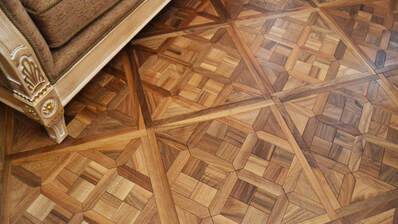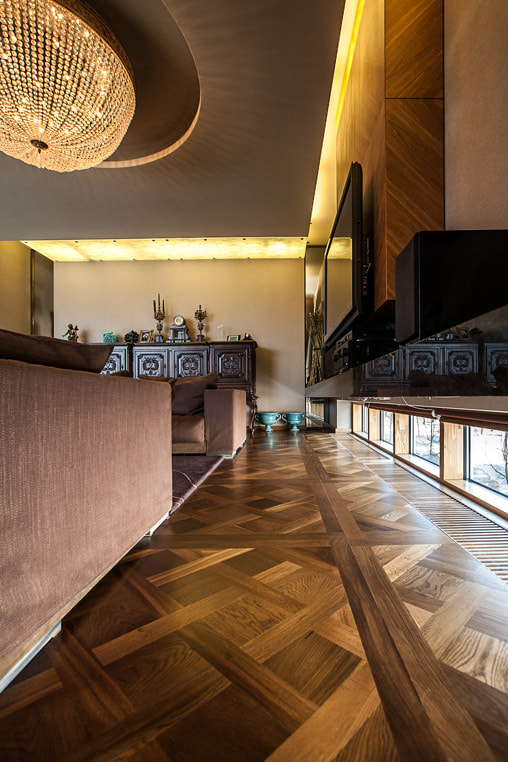|
The wood of the Walnut tree has long been prized for it''s extraordinary beauty. When selecting the perfect walnut wood flooring for your visionary renovation, it's useful to get to grips with the fundamental difference between the two types of walnut wood that you may wish to choose from. Both types of walnut are celebrated for their versatility and aesthetic value, and are in fact two distinct species within the Junglans genus. American black walnut, as it is most commonly known, possesses the botanical name Juglans Nigra, while European walnut is the common name for the species Juglans Regia. Fascinatingly, the etymology of the botanical name Junglans can be traced back to the Romans. The roots of this word are with the mythology of Roman god Jupiter, who was said to have dined on walnuts when he lived on earth. This is certainly a romantic association to bring into any interior!
Getting Acquainted With American Black Walnut American Black Walnut is native to North America, and, aside for it's value in woodworking, has long been used medicinally, while featuring as a common plot motif in Native American creation myths. When it comes to woodworking, these substantial and impressive trees are prized for their height and width. This wood's impressive durability and stability makes it perfectly suited for hardwood flooring. Black American walnut wood flooring offers an attractive and practical option for those seeking solid hardwood or engineered walnut wooden floors. Visually, the most treasured aspect of black American walnut wood flooring is certainly it's colour. American black walnut provides, as you might imagine, a dark and richly hued surface. Pigments within the heart wood range from chocolaty browns, to almost black. Hints of deep purple and burgundy are common. Highlights and sapwood feature creamy, and dark honey shades. The grain of black American walnut wood flooring is generally smooth and softly undulating. Interesting features such as incredible curls, knots, crotches, and burls do appear, and may be avoided or sought out, depending on the desired aesthetic! Becoming Familiar With European Walnut Junglians Regia, although now known commonly as European Walnut, was in fact a native species that spanned from Eastern Europe as far as Western China. It was the Romans who first brought this tree further into Europe, thanks to it's delicious nut. It is now naturalised in much of Europe and the UK, although it is worth noting that both American black walnut and European walnut have journeyed across the Atlantic to be grown in smaller numbers on the opposing continent! Not quite as long and straight growing as it's cousin of the Americas, European Walnut certainly boasts some interesting features in terms of grain patterns. What they do have in common is fantastic versatility and durability in woodworking. This makes walnut wood a highly desirable hardwood for carpentry, and of course spectacular walnut wood flooring! In terms of appearance, European Walnut tends to be a little lighter and cooler in tone than American black walnut. Colours range from richer honey hues through to gentle greys and creams, with the very occasional red or orange flare. Thanks to the wood's distinctive palette and curvaceous graining, it is often described as smokey in appearance. Although the wood fundamentally has quite a straight grain, spectacular figuring is common thanks to the nature of it's characterful growth. Wild curls, beeswing, stump, crotch, and burl figuring are common, alongside the presence of intricate knots. So, Which To Choose For Your Walnut Wooden Floors? As you might imagine with this type of wood, the grain aesthetic for walnut wood flooring can vary greatly depending on factors such as the unique individuality of each tree, the growing location, and simply what you ask your hardwood flooring specialist to seek out on your behalf! Perhaps the most pressing consideration between these two woods is the colouring – with each offering it's own special beauty. Black American walnut wood flooring is hugely popular thanks to it's decadently deep shades. European Walnut, equally so, for it's paler, but no less distinctive colour palette. Both will provide astonishing potential in terms of patterning and interest. It is easy to understand why these hardwoods are coveted for flooring all over the world. If you dream of walnut wooden floors for your next project, contact the team at Unique Bespoke wood to explore the opulent options available to you!
2 Comments
1/25/2021 11:53:44 pm
In the end, it really boils down on the kind of aesthetic that you want. In terms of appearance, European Walnut tends to be a little lighter and cooler in tone than American black walnut.
Reply
Leave a Reply. |
- Home
-
Collections
- Timeless - Engineered Wood Flooring
- Solid Wood Flooring
- Chevron Parquet Flooring
- Parquet
- Wide Plank Wood Floor
- Live Edge Wood Flooring
- Engineered Ash Wood Floor
- Engineered Walnut Wood Floor
- Textured Wood Flooring
- Versailles Parquet
- Parquet Panels
- Mansion Weave Parquet
- Antique Wood Flooring
- Wood Cladding
- Charred Wood
- Wood For Stairs
- Unfinished Wood Flooring >
- Bespoke Wood Floor
- Services
- Information
- Room Ideas
- BLOG
- Contact
- FAQ
- Trade Program
|
|
|
UNIQUE BESPOKE WOOD
74/76 MONTROSE TERRACE, EDINBURGH, EH7 5DP
UNITED KIGDOM
[email protected] / 01316529873
74/76 MONTROSE TERRACE, EDINBURGH, EH7 5DP
UNITED KIGDOM
[email protected] / 01316529873
FOLLOW US ON SOCIAL MEDIA
© COPYRIGHT 2022. ALL RIGHTS RESERVED.



 RSS Feed
RSS Feed